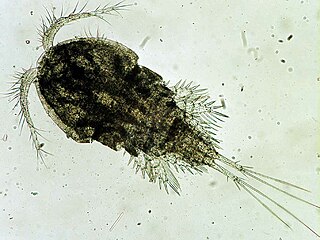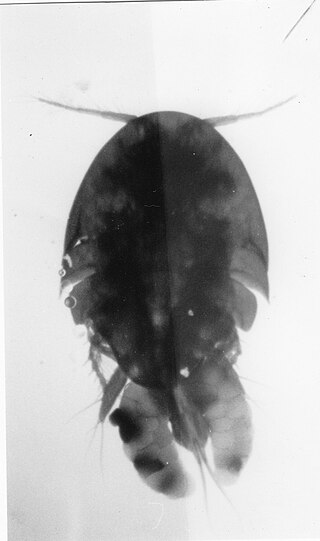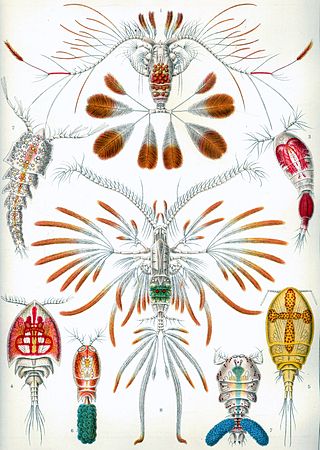
Tantulocarida is a highly specialised group of parasitic crustaceans that consists of about 33 species, treated as a class in superclass Multicrustacea. They are typically ectoparasites that infest copepods, isopods, tanaids, amphipods and ostracods.

Siphonostomatoida is an order of copepods, containing around 75% of all the copepods that parasitise fishes. Their success has been linked to their possession of siphon-like mandibles and of a "frontal filament" to aid attachment to their hosts. Most are marine, but a few live in fresh water. There are 40 recognised families:

The Cyclopoida are an order of small crustaceans from the subclass Copepoda. Like many other copepods, members of Cyclopoida are small, planktonic animals living both in the sea and in freshwater habitats. They are capable of rapid movement. Their larval development is metamorphic, and the embryos are carried in paired or single sacs attached to first abdominal somite.

Calanus is a genus of marine copepod in the family Calanidae. The genus was split in 1974, with some species being placed in a new genus, Neocalanus. The following species are recognised:

Canthocamptidae is a family of copepods. Most of the 700 species are confined to fresh water, although there are also marine species. It contains the following genera:

George Stewardson Brady was a professor of natural history at the Hancock Museum in Newcastle-upon-Tyne who did important volumes on Copepoda and Ostracoda, including those from the Challenger expedition.

Ectinosomatidae is a family of the Harpacticoida, a huge group of crustaceans belonging to the subclass Copepoda. Like most of their relatives, they are usually benthic inhabitants of marine environments. Ectinosomatidae commonly inhabit sediment and fragments of dead corals or glass sponges, and occasionally algae and bryozoans, in the deep oceans. In the epifaunal species, the first leg pair is often modified to allow the animals a better grip on the substrate.

Sapphirina, whose members are commonly known as sea sapphires, is a genus of parasitic copepods in the family Sapphirinidae.

Clausidiidae is a family of parasitic copepods in the order Cyclopoida, containing the following genera:
Clausiidae is a family of parasitic copepods in the order Cyclopoida,
Centropagidae is a family of copepods in the order Calanoida. Its members are particularly known as plankton in coastal waters and in fresh water in Australia and southern South America. They are also found on subantarctic islands and in lakes in Antarctica.

Pontella is a marine copepod genus in the family Pontellidae. It is an organism that bears three lenses in the eye. The outer has a parabolic surface, countering the effects of spherical aberration while allowing a sharp image to be formed.
Centropages is a genus of copepods in the family Centropagidae with 34 known marine species.

Cryptopontius is a genus of copepods in the family Artotrogidae.

The clade Multicrustacea constitutes the largest superclass of crustaceans, containing approximately four-fifths of all described crustacean species, including crabs, lobsters, crayfish, shrimp, krill, prawns, woodlice, barnacles, copepods, amphipods, mantis shrimp and others. The largest branch of multicrustacea is the class Malacostraca.

Temora is a genus of copepods in the family Temoridae. The World Register of Marine Species lists the following species:
Asterocheres lilljeborgi is a species of copepod in the family Asterocheridae. It is found in the British Isles and Scandinavia where it is a semi-parasite of starfish. First described as Asterocheres lilljeborgi in 1859 by the Norwegian marine biologist Jonas Axel Boeck, it is the type species of the genus.
Oithona is a planktonic crustacean genus found in marine, brackish, fresh water environments. Oithona has been described as the most ubiquitous and abundant copepod in the world's oceans. It was first described by Baird in 1843 using the species Oithona plumifera as taxon type.
Aetideidae is a family of copepods belonging to the order Calanoida.













